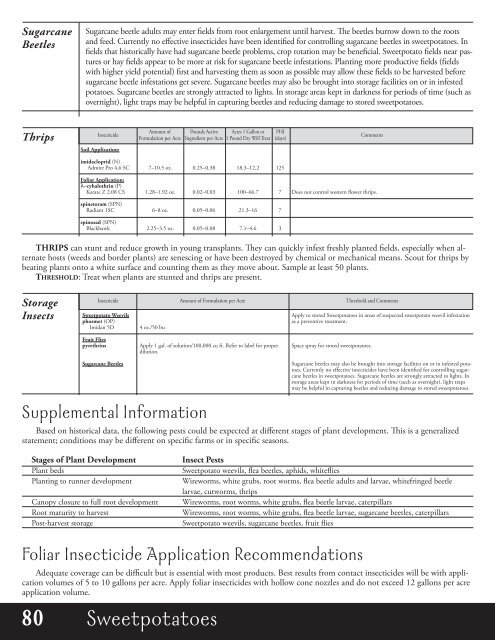Agronomic Crops
mJyPrJ
mJyPrJ
You also want an ePaper? Increase the reach of your titles
YUMPU automatically turns print PDFs into web optimized ePapers that Google loves.
Sugarcane<br />
Beetles<br />
Sugarcane beetle adults may enter fields from root enlargement until harvest. e beetles burrow down to the roots<br />
and feed. Currently no effective insecticides have been identified for controlling sugarcane beetles in sweetpotatoes. In<br />
fields that historically have had sugarcane beetle problems, crop rotation may be beneficial. Sweetpotato fields near pastures<br />
or hay fields appear to be more at risk for sugarcane beetle infestations. Planting more productive fields (fields<br />
with higher yield potential) first and harvesting them as soon as possible may allow these fields to be harvested before<br />
sugarcane beetle infestations get severe. Sugarcane beetles may also be brought into storage facilities on or in infested<br />
potatoes. Sugarcane beetles are strongly attracted to lights. In storage areas kept in darkness for periods of time (such as<br />
overnight), light traps may be helpful in capturing beetles and reducing damage to stored sweetpotatoes.<br />
Thrips<br />
Insecticide<br />
Amount of<br />
Formulation per Acre<br />
Pounds Active<br />
Ingredient per Acre<br />
Acres 1 Gallon or<br />
1 Pound Dry Will Treat<br />
PHI<br />
(days)<br />
Comments<br />
soil Application:<br />
imidacloprid (N)<br />
Admire Pro 4.6 SC<br />
7–10.5 oz.<br />
0.25–0.38<br />
18.3–12.2<br />
125<br />
Foliar Application:<br />
λ–cyhalothrin (P)<br />
Karate Z 2.08 CS<br />
1.28–1.92 oz.<br />
0.02–0.03<br />
100–66.7<br />
7<br />
Does not control western flower thrips.<br />
spinetoram (SPN)<br />
Radiant 1SC<br />
6–8 oz.<br />
0.05–0.06<br />
21.3–16<br />
7<br />
spinosad (SPN)<br />
Blackhawk<br />
2.25–3.5 oz.<br />
0.05–0.08<br />
7.1–4.6<br />
3<br />
tHRIPs can stunt and reduce growth in young transplants. ey can quickly infest freshly planted fields, especially when alternate<br />
hosts (weeds and border plants) are senescing or have been destroyed by chemical or mechanical means. Scout for thrips by<br />
beating plants onto a white surface and counting them as they move about. Sample at least 50 plants.<br />
tHResHoLD: Treat when plants are stunted and thrips are present.<br />
Storage<br />
Insects<br />
Insecticide<br />
sweetpotato Weevils<br />
phosmet (OP)<br />
Imidan 5D<br />
4 oz./50 bu<br />
Amount of Formulation per Acre<br />
Threshold and Comments<br />
Apply to stored Sweetpotatoes in areas of suspected sweetpotato weevil infestation<br />
as a preventive treatment.<br />
Fruit Flies<br />
pyrethrins<br />
Apply 1 gal. of solution/100,000 cu ft. Refer to label for proper<br />
dilution.<br />
Space spray for stored sweetpotatoes.<br />
sugarcane Beetles<br />
Supplemental Information<br />
Sugarcane beetles may also be brought into storage facilities on or in infested potatoes.<br />
Currently no effective insecticides have been identified for controlling sugarcane<br />
beetles in sweetpotatoes. Sugarcane beetles are strongly attracted to lights. In<br />
storage areas kept in darkness for periods of time (such as overnight), light traps<br />
may be helpful in capturing beetles and reducing damage to stored sweetpotatoes.<br />
Based on historical data, the following pests could be expected at different stages of plant development. is is a generalized<br />
statement; conditions may be different on specific farms or in specific seasons.<br />
stages of Plant Development<br />
Plant beds<br />
Planting to runner development<br />
Canopy closure to full root development<br />
Root maturity to harvest<br />
Post-harvest storage<br />
Insect Pests<br />
Sweetpotato weevils, flea beetles, aphids, whiteflies<br />
Wireworms, white grubs, root worms, flea beetle adults and larvae, whitefringed beetle<br />
larvae, cutworms, thrips<br />
Wireworms, root worms, white grubs, flea beetle larvae, caterpillars<br />
Wireworms, root worms, white grubs, flea beetle larvae, sugarcane beetles, caterpillars<br />
Sweetpotato weevils, sugarcane beetles, fruit flies<br />
Foliar Insecticide Application Recommendations<br />
Adequate coverage can be difficult but is essential with most products. Best results from contact insecticides will be with application<br />
volumes of 5 to 10 gallons per acre. Apply foliar insecticides with hollow cone nozzles and do not exceed 12 gallons per acre<br />
application volume.<br />
80 Sweetpotatoes


